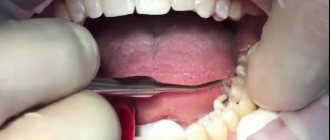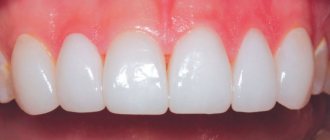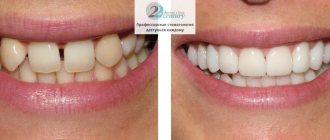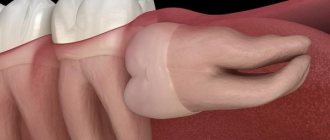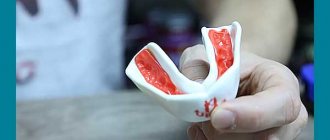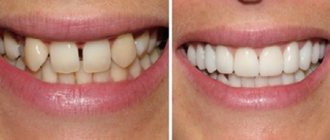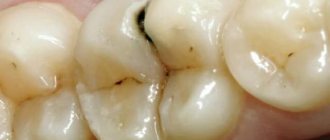Ceramic or metal-free crowns began to be used in dental prosthetics relatively recently. Compared to metal and metal-ceramic crowns, ceramic dentures are more aesthetically pleasing; for this reason, they are most often used to restore front teeth, which are clearly visible to others when smiling and talking. Aesthetics is not the only advantage of metal-free dental crowns; they have a number of other advantages that ensure their high demand among both patients and orthodontists.
In this article we will tell you in detail about ceramic (metal-free) dental crowns. After reading the material, you will learn in what clinical situations ceramic crowns are recommended for dental prosthetics, what features and unique advantages they have. We will look at the types of ceramic dental crowns, their manufacturing technologies, as well as prices for metal-free crowns in Moscow.
Design features of ceramic (metal-free) dental crowns
A ceramic crown is a prosthesis placed on a tooth or installed on an implant. Its peculiarity is that it is produced without the use of a metal base, which is used for the manufacture of metal-ceramic crowns. Modern metal-free dental crowns can be made from dental ceramics, glass ceramics, and zirconium dioxide.
Ceramics, glass ceramics and zirconium are materials that have the highest aesthetics. They have a translucency like natural tooth enamel, so metal-free dental crowns are almost impossible to distinguish from natural teeth. A wide range of colors and shades of materials allows you to get an ideal smile with straight and beautiful teeth as a result of prosthetics.
But in addition to beauty, metal-free dental crowns are completely reliable and functional products. Their installation allows you to qualitatively restore all the most important functions of the teeth and obtain the correct distribution of the chewing load.
Of course, the price for ceramic dental crowns will be higher than for prosthetics with metal and ceramic crowns. But the cost of ceramic prosthetics is well worth the benefits that can be obtained by choosing ceramic crowns.
Below we will analyze in detail all the benefits that a patient can receive by choosing ceramic crowns for prosthetics.
What is the service life of a ceramic crown?
Metal-ceramic crowns are fixed with dental cement, which breaks down after about 5 to 7 years. However, ceramic dentures are attached to a particularly strong adhesive material, which increases their service life to 10 years.
As for strength, ceramic crowns can easily withstand the required chewing load. If a ceramic crown chips for some reason, it can be easily restored. Since the metal-free structure does not have a frame, almost any minor damage to it will be invisible. If more or less serious damage occurs, the all-ceramic crown can simply be polished.
The main advantages of ceramic dental crowns
What benefits can you get by choosing to put ceramic crowns on your teeth? This question is often asked by patients to orthodontists, and therefore below we will consider in detail all the advantages of metal-free dental crowns.
The main advantages of using ceramic crowns for dental prosthetics include:
- An ideal indicator of the compatibility of dental ceramics with natural tissues of the human body. Ceramic crowns do not lead to allergic reactions, their surface does not darken or change its attractive color under the influence of external factors, wearing them does not cause an unpleasant metallic taste in the mouth;
- Aesthetics of prostheses. If you decide to put ceramic crowns on your front teeth, you can be sure that strangers will not even notice that you have not your own teeth, but a prosthesis;
- The use of modern technologies allows the prosthetist to make ceramic crowns individually for the patient. The finished prosthesis will fit tightly to the core base, without gaps, and such high precision in the production of metal-free crowns ensures a long service life and eliminates the occurrence of inflammation and caries in the tooth under the crown;
- Metal-free crowns are not massive, are light in weight (compared to bulky and heavy metal prostheses), they do not create dangerous unwanted stress on adjacent healthy teeth and gums;
- Ceramic crowns have an absolutely smooth surface that does not stain from contact with food, does not accumulate plaque, and does not absorb odors.
With so many advantages, ceramic dental crowns also have certain disadvantages that are important to consider before you decide to place them on your front or chewing teeth.
Contraindications for installation
The main contraindication to the use of a fixed prosthesis is considered to be poor oral hygiene. Over time, plaque may form around the “cap,” which damages the periodontium and intensifies caries. Therefore, first, teeth are cleaned, damaged teeth are removed, carious cavities are filled, and foci of inflammation are treated. Only then can the crown be installed.
Temporary contraindications also include:
- age up to 16-18 years (individually, they look to see if the jaw continues to grow and the roots of the teeth continue to form);
- severe health condition (heart attack, ischemia, hypertensive crisis).
Absolute contraindications:
- Completely healthy teeth (intact), when they do not serve as support for devices or dentures.
- Pathological tooth mobility of the 3rd degree (mobility with an inclination, the tooth can rotate 360 degrees).
- Incurable infection in the periodontal area.
Some disadvantages of ceramic crowns that are important to consider before prosthetics
When planning to place ceramic crowns on your front or chewing teeth, it is important to take into account certain disadvantages of dentures made from this material:
- Some types of ceramics are quite fragile and cannot withstand the pressure that occurs when biting and chewing food. For example, porcelain crowns can crack and chip from a strong impact. If high strength is required from the crown for dental prosthetics, then it is better to initially opt for metal-free prostheses made of zirconium or pressed ceramics;
- Difficulty of restoration. If a ceramic crown is damaged, it is easier to replace it completely than to try to repair a broken denture.
Some people consider the disadvantages of ceramic crowns to be their high price. Of course, the price of ceramic crowns is much higher than that of metal and metal-ceramic prostheses. But only ceramic prosthetics allows you to achieve a truly high level of aesthetics, and if the crown is made correctly and accurately, and you take proper care of it, it will serve you no less than a metal prosthesis.
Differences between crowns and ceramic inlays
The doctor decides what to restore a tooth with - a ceramic inlay or a crown - after assessing its condition. If more than 60% is destroyed, a crown is used, if from 40 to 50%, a ceramic inlay is used. The design does not require removal of the nerve and allows the preservation of a living dental unit. To some extent, the inlay is an analogue of a light-curing filling, but differs from it in that it is made in a dental laboratory using individual impressions, is characterized by high strength and fits as tightly as possible to the dental tissues.
Which teeth can be replaced with ceramic crowns?
Metal-free crowns can restore any tooth in the row - both the front and chewing ones. You just need to choose the right type of material. For example, for the restoration of teeth in the smile area, you can choose porcelain, ceramics, and glass ceramics. Zirconium crowns are more suitable for the restoration of posterior teeth.
Why do prosthetists recommend using radically different materials for prosthetics of back and front teeth? It's simple: the front and chewing teeth perform different functions and experience different degrees of stress. The heaviest load when eating food is placed on the back teeth, therefore the crown for their restoration must be strong. Therefore, for prosthetics of chewing teeth, metal-free zirconium crowns are most often used; their strength level is not inferior to metal products. The average price of zirconium oxide crowns per chewing dental unit is twenty thousand rubles.
USEFUL TO KNOW: To fix metal-free crowns on the back (chewing) teeth, not glue, but cement is often used, which allows you to secure the prosthesis as firmly as possible on the stump base.
When replacing anterior teeth, the strength of the crowns is less important, since the incisors and canines are less subject to stress. Here the primary indicator will be aesthetics - after all, the crown on the front teeth should look natural and be invisible to others. Therefore, when prosthetizing the front teeth, ceramic, porcelain and glass-ceramic crowns are relevant. The price of the crown will depend on the type of material.
USEFUL TO KNOW: The aesthetics of prosthetic restoration of the front teeth with ceramic crowns will depend on the accuracy of the manufacture of the prosthesis and the correct choice of its color.
Photos before and after prosthetics, which we supplement our article, will help you evaluate what ceramic and zirconium crowns look like on your teeth.
Types of metal-free (ceramic) crowns for teeth
Having told you about the pros, cons, and possibilities of installing ceramic crowns on the front and back teeth, let's talk about the types of orthopedic products made from this material. There are three main types of metal-free dental crowns:
- All-ceramic. These dental crowns are made from dental porcelain and have a fairly affordable price. They have a high level of aesthetics, but are very unstable to mechanical loads. For this reason, all-ceramic crowns are installed during prosthetics only in the area of the front teeth;
- All-zirconia crowns. They are made from zirconium oxide and have increased strength, allowing them to be used for prosthetics of back teeth - molars, which take an active part in the process of chewing food;
- Crowns on a zirconium frame with ceramic veneer. Such combined crowns provide both strength and high aesthetics and therefore can be used for the restoration of both anterior and chewing teeth.
What type of ceramic crowns is best for your case? Only a doctor can answer this question accurately and in detail, after examining and studying all the features of the clinical case, as well as taking into account your wishes. If you need detailed advice on dental prosthetics with ceramic crowns, you can get it at any time convenient for you by visiting an orthopedic doctor’s office in our dental clinic in Moscow - “Firadent”.
Properties of ceramics
The main advantage that metal-free crowns have is biological inertness. This means that the human body does not react to prostheses as if they were a foreign object and does not reject them. Ceramic teeth have other advantages:
- they contain no harmful impurities;
- the material does not absorb any odors;
- crowns made of metal-free ceramics do not stain and do not react with bacteria and pigments;
- designs do not cause gum inflammation;
- strength;
- visually similar to natural teeth;
- an all-ceramic crown allows you to accurately reproduce the natural shade, transparency and even the structure of bone tissue;
- ceramic fixed dentures do not have a metal frame - accordingly, they are much thinner and lighter than their “brothers”.
When is it possible and when not to perform dental prosthetics with ceramic crowns?
The main indications for dental prosthetics with ceramic crowns will be as follows:
- More than 50% tooth decay;
- Absence of a tooth in any part of the dentition;
- The need to eliminate an aesthetic defect: a chipped tooth, unsightly enamel color;
- Tooth restoration after injury (provided the tooth root remains intact and healthy);
- An allergic reaction to metal alloys, excluding the use of metal dentures.
Dental prosthetics with ceramic crowns are not performed if the location of the pulp (nerve of the tooth) is too close, as well as with advanced periodontitis. Contraindications to the installation of metal-free crowns are excluded at the stage of diagnosis and treatment planning.
Firing technology
This technology for making ceramic dental crowns involves firing them on a fire-resistant model, which is made from special heat-resistant materials. Crowns produced using this technology have a number of advantages:
- Short production times and at the same time high accuracy rates of the finished crown;
- Various substances can be added to the ceramic sintered mass to obtain both improved strength characteristics and the desired color of the finished ceramic crown, which ideally matches the natural shade of the patient’s tooth enamel;
The advantages of ceramic crowns produced using firing technology include an affordable price.
CAD/CAM
The considered method of producing ceramic dental crowns involves the production of structures on a special milling machine. The model from which the tooth crown will be made is created using a special computer program and then transferred to a milling machine.
The manufacturing technology of a ceramic crown for dental prosthetics will affect its price. Therefore, when drawing up a prosthetic plan, the doctor, together with the patient, will decide on the method of production of the prosthesis.
The main stages of manufacturing ceramic crowns for dental prosthetics
The process of making ceramic crowns for dental prosthetics will consist of the following steps:
- Diagnostic stage. At this stage, the patient undergoes an examination by an orthopedic dentist, after which it is decided which crowns to put on the teeth and a treatment plan is drawn up.
- Preparation stage. Before placing a ceramic crown on a tooth, you need to properly prepare not only the tooth itself for prosthetics, but also the oral cavity as a whole. To do this, professional teeth cleaning is carried out, and dental diseases of the teeth and gums diagnosed during the examination are treated. The preparation stage also includes depulping the tooth and turning it, which makes it possible to obtain a stump base on which the doctor will place a ceramic crown.
- An impression is taken from the prepared teeth, from which a model of the future crown is made.
The production time for a ceramic crown on a tooth will depend on the technology. When the ceramic crown is ready, the patient is invited to the clinic to try it on and temporarily install it on the tooth. If these measures do not reveal any defects in the finished crown, the patient will not complain of discomfort when wearing the prosthesis - the crown is fixed to the tooth on a permanent basis.
Features of prosthetics
Preparation for installing a crown involves a visual examination of the damaged tooth by an orthodontist, x-rays, treatment, and a filling must be placed under the prosthesis. After the described manipulations, the corresponding tooth is ground (the required layer of bone tissue is removed - its thickness is usually 1.5–2 mm, depending on the size of the crown walls).
Important! If the tooth apex is completely missing, a metal inlay is placed under the ceramic prosthesis.
Otherwise, the procedure for prosthetics using ceramic material is no different from working with other crowns. Dentists perform manipulations in the following sequence:
Crown inlay
- First, a cast is made;
- make a model of the future product from plaster;
- select the required shade of ceramics (in accordance with a special scale);
- Then the crown itself is made in the laboratory.
The last stage of prosthetics is fitting (adjusting) the structure, fixing it first with temporary cement, and then with a previously prepared tooth. Upon completion of the manipulations, the patient may experience unpleasant painful sensations.
Lightness, strength, hypoallergenicity, aesthetically attractive appearance - these are the properties due to which ceramic prostheses are gradually displacing their metal and metal-ceramic counterparts from the dental market
Discomfort occurs for various reasons:
- if the size and shape of the crown were initially chosen incorrectly;
- when the edges of the product do not fit tightly to the gum.
How do ceramic crowns stay on teeth?
How do ceramic crowns stay on teeth? This question is often asked by patients planning to put ceramic crowns on their teeth, and we will answer it in detail below.
To place a ceramic crown on a tooth and firmly fix it on it, the doctor will not sharpen the tooth much or install a pin under the root. He removes a small amount of tissue from the tooth so as to obtain enough space for placing the ceramic crown itself on the stump and its subsequent fixation with glue. As a result, the crown “sits” tightly on the tooth and there are no cracks or gaps left between the ceramic product and the natural tissues of the tooth.
The glue will firmly hold the ceramic crown in place and at the same time, the border between the prosthesis and the tooth will remain invisible. The invisibility of the connection between the ceramic crown and the tooth is of fundamental importance when carrying out prosthetics in the area of the anterior teeth.
If a ceramic crown is planned to be placed on a chewing tooth, strong dental cement is used to secure it firmly to the stump.
How long can a ceramic tooth crown last?
Ceramic crowns are durable and wear-resistant - they can serve their owner for ten years or more. But at the same time, you need to properly care for the ceramic crown after prosthetics, maintain oral hygiene and periodically undergo examination by a dentist.
If you have all-ceramic crowns placed on your front teeth, you should refrain from biting and chewing hard foods. A ceramic crown may not be able to withstand such a load, and if it breaks, then it will have to be removed, restored and reinstalled.
Ceramic crowns do not require any special care after prosthetics - you can care for them just like your natural teeth.
Possible complications after the procedure
Complications are rare after crown placement, but complications do occur. Most often this is a medical error or lack of professionalism. Therefore, the best prevention of complications is choosing a clinic with an excellent reputation. In addition, there are several diseases that do not depend on the doctor. They can be caused by medications, gastrointestinal diseases, and injuries.
Complications after crown installation
Prosthetic stomatitis (allergy)
Stomatitis, the cause of which is dentures, happens:
- allergic, this is a contact allergic inflammation, which often occurs after repeated prosthetics;
- toxic (occurs more often than allergic).
Prosthetic allergic stomatitis is a reaction to metal compounds and plastic. The more metal (a large number of bridges, crowns), the more likely an allergy. Moreover, this type can develop both immediately after installation and after 5-15 years of wearing crowns. Patients with gastrointestinal diseases and endocrine disorders are at risk. Typical complaints are swelling of the mucous membranes of the oral cavity and larynx, sometimes it is difficult to breathe, the tongue swells and does not fit in the mouth, but there are no ulcers familiar to ordinary stomatitis.
If a metal, metal-ceramic or metal-plastic crown is installed, a burning sensation of the tongue, drooling, and dry mouth are noted. If you are allergic to acrylates, granular bright red foci of inflammation appear on the mucous membrane of the palate, matching the shape and size of the prosthesis. In addition, skin reactions are noted - eczema, urticaria, dermatitis.
With toxic prosthetic stomatitis, the mucous membrane is damaged, and there is massive destruction of the epithelium of kidney, liver, intestinal cells, red blood cells, and nerve cells. Most often, poisoning is caused by stainless steel; if the crown (whole or base) is made of gold or a silver-palladium alloy, the disease occurs much less frequently.
This complication appears 1-7 days after installation. Characteristic symptoms of toxic denture stomatitis:
- burning tongue;
- drooling (hypersalivation);
- unpleasant feelings in the tongue, such as tingling, rawness (glossalgia);
- nervous disorders;
- gastrointestinal disorders.
Caries on supporting teeth
The ground teeth under the crown, if the nerve is removed, dry out over time. As soon as the seal is broken, bacteria and food particles penetrate under the denture and caries develops. That is why, even if part of the tooth and the root remain, it is better to build up the support than to remove the tooth along with the nerve.
Jaw trauma and hard food lead to a violation of the integrity of the crown and further development of caries underneath it. Development is promoted by poor oral care.
Galvanic syndrome
Saliva is a complex electrolyte, and the oral cavity is an electrochemical system in which:
- saliva (liquid phase), saturated with oxygen and carbon dioxide, acts as an electrolyte;
- teeth, dentures (solid phase) act as electrodes.
If there are metallic inclusions in the oral cavity that are not covered with ceramics (insulator), the potential of the electrode system increases sharply. There is a feeling of acidity and burning in the mouth. With a galvanic symptom, the functioning of the nervous system is disrupted, which leads to a general deterioration in the patient’s condition.
How much does it cost to put a ceramic crown on a tooth?
The approximate price for a ceramic crown for dental prosthetics is about 20 thousand rubles. The indicated price includes the ceramic crown itself, as well as tooth preparation services that must be carried out in order to install the prosthesis. The price of the crown will consist of the following factors: the price of the material, technology for manufacturing the prosthesis, and the complexity of the clinical case.
But the total price of prosthetics with ceramic crowns may be higher than the indicated amount, because some additional procedures may be carried out during treatment: for example, sanitation of the oral cavity, tooth depulpation, treatment of dental canals. Therefore, it is better to find out the exact price of a crown directly in the clinic, from an orthopedic dentist. The doctor will conduct an examination and offer you the prosthetic option that suits you in terms of aesthetics, functionality and price.
USEFUL TO KNOW: in advertising offers from some clinics you can see a fairly low price for ceramic crowns - from seven thousand rubles. But believe me, such a price is not a reason for joy. Most likely, at this price, patients are offered either metal-ceramics, or it is simply the price of the crown itself, without treatment and preparation of the tooth, and in the end the cost of prosthetics will be 3-4 times higher. Therefore, do not be tempted by beautiful advertising and the opportunity to save money - always find out all the details about dental prosthetics in a specific clinic!
If you want to find out the exact price of prosthetics with ceramic crowns, call or come to an appointment with our specialists at the dental clinic in Moscow - “Firadent”. We do not promise our patients the lowest prices for prosthetics and installation of ceramic crowns, but we guarantee high quality and comfort of treatment!
Cost of installing a crown on an implant
A ceramic crown can be placed not only on a tooth, but also on an implant. The price of such prosthetics will be more expensive, since it will include the cost of the implant, the operation for its implantation, and in some cases the price of preliminary osteoplasty. But the high cost in this case will be compensated by the reliability and durability of the result, its high aesthetics, and in addition, installing a crown on an implant does not require grinding down healthy teeth.
It is also impossible to announce the exact price of installing a ceramic crown on an implant right away and without taking into account a number of important factors. The price of the service will depend on the type of implant, the complexity of the clinical case, the technology of implantation, the material and manufacturing technology of the ceramic crown. Therefore, the exact price for installing a ceramic crown on a turnkey implant can only be determined after visiting a dental clinic.
You can always get detailed and honest answers to any questions about prosthetics and dental implantation by contacting our dentistry in Moscow - Firadent.
Free consultation on the cost of treatment in our dentistry
Leave a request and the clinic administrator will contact you within 15 minutes!
For single-rooted dental units, the depulpation process is mandatory, since the risks of thermal burns during grinding are quite high and this is fraught with the future development of an inflammatory process under the crown. Single-rooted teeth are drilled out, the nerve is removed, and the canals are cleaned and filled.
If there are dental diseases - caries, pulpitis, periodontitis - manipulations are performed to treat them. The nerves of the unit are removed, the canals are expanded with a special instrument, filled with gutta-percha, after which a filling is installed on the tooth itself. In case of serious damage to a tooth due to caries, it is important to install a strong filling and provide additional fixation. If this is not done, the dental crown may simply fall out along with a poor-quality filling. The process of restoration of a natural dental crown can be implemented in practice using two methods:
1. Installing a crown on a pin. The pin element is screwed into a pre-filled root canal and the natural coronal part of the tooth is restored at its base. After the filling is made, it is ground down to install the crown.
2. Using a stump insert. This element is manufactured in laboratory conditions and, when installed, is fixed in two areas at once: the dental canal and the area of the natural tooth crown.
These labor-intensive manipulations are carried out exclusively in the presence of serious destruction in the area of the natural dental crown, and if we compare the methods in terms of reliability, then the most high-quality result can be obtained by placing a stump inlay.
